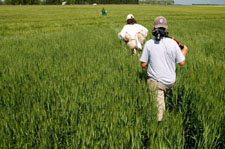

 Sab Kim
Sab Kim
Jet Propulsion Laboratory
Updates on the vegetation conditions are provided here, monitored by the crop structure team. There were localized thunderstorms on July 15th, which gave 8 mm rainfall according to the local weather data. I happened to be in the field(!) and believe the campaign fields received much more. Some fields outside the low-altitude flight lines were not visited by the structure team. The conditions of these fields were instead monitored by the vegetation teams.
All the crops grew enough to start to make grains, and the percent ground covered by the vegetation was 80% to 100%, according to observations made between July 7th and 17th. The corn plants grew to 225cm high and will not grow much further even after the rainfall on 15th. Instead tassels and ears are developing, but no cobs yet.
For more information, visit the SMAP Blogs From the Field site.
 Steven Chan
Steven Chan
Jet Propulsion Laboratory
As an avid photographer, I totally agree with what Diane Arbus said, “I really believe there are things that nobody would see if I didn’t photograph them.” So here in this blog I’m taking a more photojournalistic approach. Enjoy!
My work in SMAPVEX12 primarily consisted of two tasks: Vegetation sampling in crop fields and soil moisture sampling in forests. The two tasks alternated according to PALS flight schedule and weather conditions. Because I arrived in July, my observations were all about the later phase of the campaign.
Our cropland vegetation sampling involved measurements of optical parameters (e.g., LAI and NDVI) and allometric parameters (e.g., height and diameter). On a typical day we visited up to six fields to collect data and actual plant samples.

Wheat had matured quite a bit since the beginning of the campaign. Here Brian, Hida (U. Guelph), and Tracy were carrying plant samples for further analysis at the ROC.

Tracy (U. Guelph) and Brian (U. Manitoba) were making LAI and NDVI measurements, respectively, in a soybean field.

Example of a typical soil profile: Litter (not shown), then organic layer (brownish orange layer), then soil (gray-colored layer), and then groundwater.
For more information, visit the SMAP Blogs From the Field site.
Grant Wiseman
Agriculture and Agri-Food Canada
Week 3 provided 7 days of much needed sunshine allowing for a study-site-wide dry down of soils and a significant increase in crop growth. Field crews were able to collect vegetation samples twice and soil moisture measurements four times!
For more information, visit the SMAP Notes from the Field page.
Andreas Colliander
Jet Propulsion Laboratory
On the second science data acquisition flight of PALS (on June 12) I got to fly on board the Twin Otter aircraft for the flight segment after the mid-day refueling stop at Winnipeg airport. Due to the minimal requirement for a second PALS operator on this flight I took Ian’s place on the plane while Seth continued to be in charge of the PALS instrument operation.
The day was beautiful, the skies mostly clear and the ride very smooth (the going can easily get bumpy on a small plane like the Twin Otter) at about 8500 ft altitude as planned for this flight.
To read more and see more images, visit the SMAP Blogs from the Field site.
Eni Njoku
We’ve been rained out for four straight days Friday through Monday due to unstable weather conditions in the area – not exactly what we expected! On the other hand we should certainly observe some pretty wet fields when we make our next PALS flights.
On Saturday things looked good in the early morning despite some low-lying fog and expectations that a weather front to the East might move into the area by early afternoon. So we gave the “Go” signal for the sampling teams to head for the fields. Meanwhile at the airport the fog thickened, so take-off was put on hold. Seth and Ian took advantage of the delay to work on some instrument troubleshooting.
By the time the fog at the airport lifted Rich determined that the weather front was moving in much faster than expected and would probably reach the edge of our sampling domain by mid-morning. So we reluctantly aborted the Twin Otter flight for the day and notified the field crew (who were no doubt also anxious not to get caught in the storm). When the storm hit it was a big one! The tornado chasers were out in force, we heard, but none were sighted according to the news (tornados, that is).
To see what else the SMAPVEX12 team does in their downtime, visit SMAP Blogs from the Field